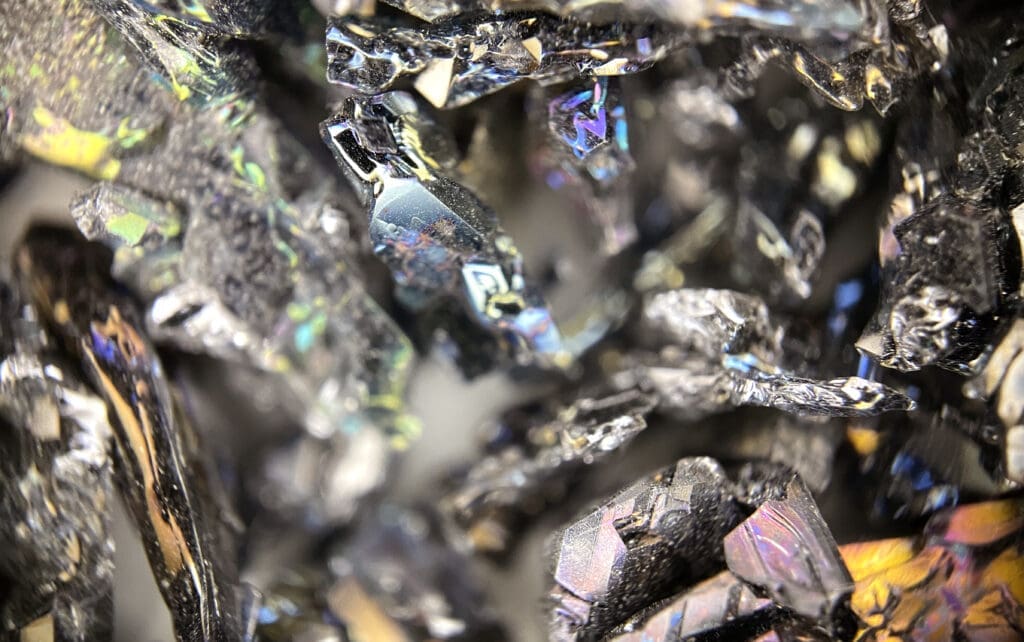
Bismuthum metallicum
Latin name: Bismuthum metallicum
Short name: Bism
Common name: Bismuth | Bismuth Metal | White Metal
Primary miasm: Syphilitic Secondary miasm(s): Psoric
Kingdom: Minerals
Family: Element | Heavy Metal
- Symptomatology
- Remedy Information
- Differentiation & Application
Bismuth is a brittle, crystalline metal (symbol Bi, atomic number 83), often found in nature in ores or as a by-product of lead and copper smelting. It has a pearlescent sheen and is chemically stable. Homeopathically, it is prepared by trituration of the pure metal, unlocking deep gastrointestinal and neurological symptoms.
Bismuth compounds (like bismuth subnitrate and subsalicylate) are used in conventional medicine as antacids, antidiarrhoeals, and treatments for Helicobacter pylori infections. Historically used in cosmetics and alloys.
Proved by Hahnemann and confirmed by Hughes, Allen, and Hering. Known for its action on the gastrointestinal tract, nervous system, and cardiac weakness.
- Stomach and gastrointestinal tract – inflammation, vomiting, ulcers
- Heart and circulation – collapse, cyanosis
- Nervous system – neuralgia, restlessness, fear
- Mucous membranes – erosion, catarrh, violent inflammation
- Face and mouth – neuralgia, pale appearance, coated tongue
- Right side – symptoms often more right-sided
- Children and elderly – sensitive to gastric collapse and restlessness
- Cold drinks (though sometimes vomited)
- Being with someone (cannot tolerate being alone)
- Pressure (in gastric pain)
- Cold air
- Rest after vomiting
- Bending forward in abdominal pain
- Being alone
- Eating, especially solid food
- Warmth or warm room
- Motion
- Touch
- Mental exertion
- Night
- Arsenicum album – Similar vomiting and restlessness, but more burning and fear of death
- Ipecacuanha – Nausea and vomiting, but with clean tongue and lack of thirst
- Phosphorus – Vomits as soon as water warms in stomach; also needy and affectionate
- Nux vomica – Gastric troubles with irritability, not fear of being alone
- Antimonium crudum – Vomiting after overeating; thick white coating on tongue
- Kreosotum – Vomits undigested food hours after eating
- Complementary: Arsenicum, Phosphorus
- Antidotes: Nux vomica, Pulsatilla
- Follows well: Antimonium crudum, Ipecacuanha
- Inimical: None specifically known
Bismuthum reflects the collapse of inner support, both physically and emotionally. The remedy centres on dependency, the need for presence, and the inability to digest life alone. Physically, food is rejected immediately; emotionally, solitude is intolerable. The dual nature of the remedy—metallic hardness and emotional fragility—reveals its purpose in healing those whose vital energy has drained away, especially after digestive shock, grief, or abandonment. Bismuthum offers reconnection—to the body, to nourishment, and to others.
- Top remedy in gastric ulcer or cancer with vomiting of all food
- Useful in infants with regurgitation and restlessness
- Consider in food poisoning, gastritis, gastroenteritis
- When patient clings, panics when alone, and vomits food immediately after eating
- Vomiting relieves temporarily, but exhaustion follows rapidly
- Top remedy in gastric ulcer or cancer with vomiting of all food
- Useful in infants with regurgitation and restlessness
- Consider in food poisoning, gastritis, gastroenteritis
- When patient clings, panics when alone, and vomits food immediately after eating
- Vomiting relieves temporarily, but exhaustion follows rapidly
- Samuel Hahnemann – Materia Medica Pura: Original proving with emphasis on gastric symptoms and vomiting
- C. Hering – Guiding Symptoms: Restlessness, vomiting, and mind-body connection
- James Kent – Lectures on Homoeopathic Materia Medica: Core mental and gastric themes
- William Boericke – Pocket Manual: Clinical notes on vomiting and collapse
- John Henry Clarke – Dictionary of Practical Materia Medica: Differential diagnosis and gastrointestinal depth
